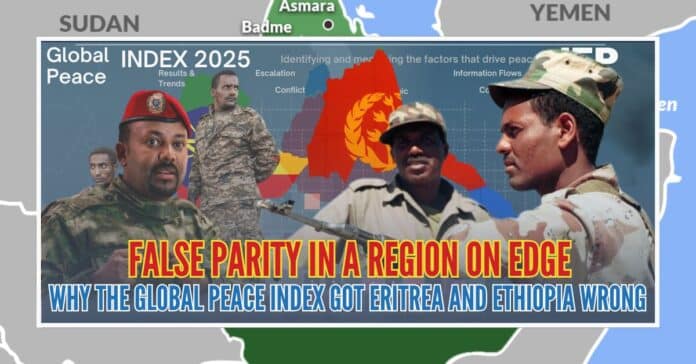In the latest edition of the Global Peace Index (GPI), Eritrea was ranked 132nd and Ethiopia 138th out of 163 countries. At first glance, the six-point difference suggests that the two nations are nearly equal in terms of peace and stability. But here’s the problem: they are not.
Anyone familiar with the Horn of Africa its recent history, its lived realities, and the sharp asymmetry in power dynamics will see that this ranking doesn’t just flatten nuance. It distorts it. The GPI, once again, falls into the trap of false equivalence, and Eritrea ends up being painted with the same brush as the very forces that have spent decades destabilizing it.
The Problem Isn’t Just the Ranking It’s the Narrative Behind It
Produced by the Institute for Economics and Peace (IEP), the Global Peace Index is widely cited by governments, media, and development organizations. It claims to be neutral and data-driven. But neutrality, when stripped of historical context, becomes complicity.
Eritrea is portrayed as a militarized, closed-off state. Ethiopia is framed as unstable but somehow still strategic. One is boxed in as “authoritarian”; the other is treated as a fragile democracy finding its way. Yet the reality is far more layered and uncomfortable for those who cling to simplistic narratives.
Let’s remember that Eritrea has been under relentless international pressure for over 20 years, facing:
- UN and U.S. sanctions based on disproven allegations.
- Decades of media defamation and diplomatic isolation.
- A refusal by the international community to enforce the 2002 Eritrea-Ethiopia Boundary Commission (EEBC) ruling, which granted the town of Badme to Eritrea.
None of this is reflected in the Peace Index’s metrics. Why? Because the metrics don’t measure injustice they measure surface-level symptoms, often gathered from biased sources.
Ethiopia: The Arsonist Framed as the Firefighter
Meanwhile, Ethiopia whose government has declared Red Sea access an “existential necessity” is staging military deployments near Eritrea’s border, building naval capacity it doesn’t yet have, and signing deals with breakaway regions like Somaliland to circumvent Eritrean ports altogether.
Internally, Ethiopia is fracturing. The Tigray conflict may have formally ended, but resentment simmers beneath the surface. In Amhara, a full-blown insurgency has broken out. Oromia remains restive. And Ethiopia’s political center is increasingly fragile.
Despite all this, the Peace Index treats Ethiopia’s militarization and expansionist ambitions as symptoms of a state under pressure not a threat to the region.
Eritrea, on the other hand, is accused of militarism because it prepares for war. But what choice does a country have when its neighbor:
- Calls its sovereign coastline negotiable.
- Signs offshore naval deals backed by foreign powers.
- And historically ignored international rulings without consequences?
This isn’t militarism. This is survival.
The Index Misses the Bigger Picture.
Let’s be clear: Eritrea’s military mobilization, its partnerships with friendly countries, and its policy of national service are not accidental. They are the outcome of betrayal, broken promises, and a world order that has never taken its sovereignty seriously.
If Ethiopia is spending over $1.5 billion a year on foreign ports and rattling sabers about the Red Sea, why shouldn’t Eritrea respond with defensive preparations? The IEP’s methodology, while presented as scientific, leans heavily on:
- Western media narratives, which have consistently misrepresented Eritrea.
- Third-party data sets, often compiled by NGOs or think tanks with direct or indirect funding from governments with strategic interests in Ethiopia. This is not conspiracy—this is reality. Just follow the money.
| Key Factor | Eritrea | Ethiopia |
|---|---|---|
| Peace Index Rank (2025) | 132nd | 138th |
| UN Sanctions History | Yes (2009–2018) | None |
| Border Ruling Compliance | Yes (EEBC, 2002) | No |
| Red Sea Rhetoric | Defensive (Sovereignty-focused) | Aggressive (Expansionist) |
| Military Deployment | Defensive, National Service | Offensive, multi-border deployments |
| Internal Conflict | No, | High (Tigray, Amhara, Oromia) |
| Foreign Military Backing | No | UAE, Russia, Iran, Türkiye |
| Conflict Exporting | No | Yes (Somalia, Tigray, Sudan) |
The Real Cost of Lazy Metrics
It’s easy to throw countries like Eritrea into the “low peace” category. It’s harder to ask why. What you won’t find in the Global Peace Index is any meaningful acknowledgment of the geopolitical bullying, the decades-long siege, or the weaponization of development aid used against nations that refuse to fall in line.
Eritrea has never begged for aid. It has never played the victim. It has, for better or worse, insisted on dignity over dependency. That comes at a cost but it’s a cost Eritreans have chosen with open eyes.
What the GPI fails to measure is resilience. What it doesn’t track is integrity. And what it conveniently overlooks is Ethiopia’s historical and ongoing role in shaping Eritrea’s security posture.
The idea that Eritrea and Ethiopia are nearly equal in peacefulness is not just inaccurate—it’s insulting. Eritrea’s struggles are real, but they are not of its own making. It is a nation that has been punished for saying “No” to foreign domination, to aid dependency, and to dictated diplomacy.
The Peace Index wants to count tanks and troop numbers. That’s fine. But until it learns to count betrayals, sanctions, illegal occupations, and double standards, it will always remain what it is: A flawed mirror held up to a distorted world.

